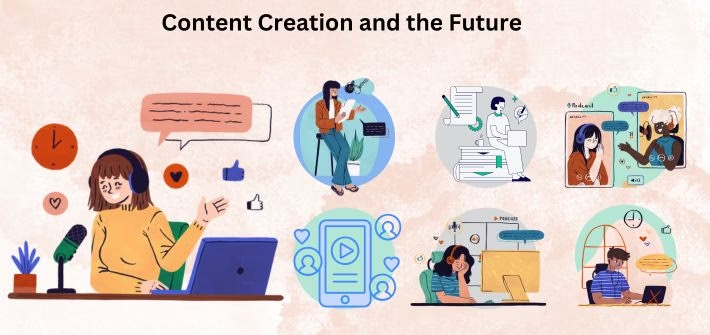Whether through digital channels, manuscripts, printed newspapers, or storytelling over a fire, content creation has always been at the core of communication. However, the way information is conceived, created, and consumed is changing significantly in today’s quickly changing digital landscape. Global interconnection, evolving audience behavior, and technological innovation are changing not only the appearance of material but also its distribution and revenue generation. In the future, a new era characterized by artificial intelligence (AI), immersive experiences, and hyper-personalization will require adaptation from creators, brands, and consumers alike.
Automation and AI in Content Creation
Content creation is currently heavily reliant on artificial intelligence, and in the years to come, this effect will only increase. AI-powered tools can now produce extraordinarily realistic photos, movies, music, and written articles in a matter of seconds. This change is democratizing creativity by enabling anyone to create high-caliber material with little funding. Businesses may increase production at a fraction of the expense because of that. But automation also calls into question originality and authenticity. Human creators will continue to be crucial for adding emotion, viewpoint, and cultural richness to content, even as AI advances in speed and efficiency. AI will probably perform tedious jobs in a collaborative model of the future, freeing up humans to concentrate on creative strategy and narrative.
Immersion Media Experiences’ Ascent
Audiences are growing more and more interested in immersive and interactive experiences as technology develops, and they are no longer content with passive consumption. The distinction between content and reality is becoming increasingly hazy due to virtual reality (VR), augmented reality (AR), and mixed reality (MR). Consider going to a live concert where digital overlays improve the performance or exploring a virtual museum display led by a historical figure. Audiences can interact with stories in more memorable and intimate ways thanks to these immersive forms. This entails a change for creators from linear storytelling to multi-sensory, dynamic narratives that change based on user engagement. With the increasing affordability of gadgets like AR glasses and VR headsets, immersive content might soon be as popular as conventional blogs and movies.

Audience Targeting and Hyper-Personalization
Personalization will be a key component of content development in the future since it is more difficult than ever to get attention in the crowded digital content market. Platforms may now monitor user activity to provide content that is customized to each user’s preferences, thanks to the input of a versatile UGC agency that takes user content to the next level. Audiences are starting to anticipate experiences created especially for them, from tailored Instagram shopping feeds to customized Spotify playlists. To make sure their work appeals to the right audience, content producers will need to consider segmentation, micro-niches, and relevancy more and more. However, there are moral questions around user consent and data privacy associated with this customisation. For platforms and creators alike, striking a balance between transparency and personalization will be a major issue.
Social Media Platforms
Although social media is still one of the most effective platforms for producing and sharing content, its function is evolving. The focus has already changed from traditional celebrities to regular producers and digital-first influencers thanks to platforms like Instagram, YouTube, and TikTok. More sophisticated monetization strategies will probably be included in these platforms in the future, providing creators with more financial power. Furthermore, content visibility will continue to be shaped by algorithm-driven discovery, which will force producers to continuously modify their approaches. Strong community-building abilities in addition to high-quality material will be necessary to stand out as competition increases. The goal of content creation will shift from spreading a message to encouraging sincere dialogue with audiences.
Human Touch and Ethical Considerations
The future of content creation will be heavily influenced by technology, but human interaction will always be crucial. Which creators are trusted and survive in their areas will depend on their authenticity, empathy, and sense of ethical duty. Consumers are becoming more adept at spotting information that seems phony or manipulative, and they appreciate openness from both companies and individual producers. Careful solutions will be needed to address ethical issues, including deepfakes, false information, and user data exploitation. There will be a big benefit for creators who put honesty and responsible narrative first. Long-term success in content creation will depend on both technological advancement and the capacity to establish deep human connections.
The future of content creation is not about man vs machine, but rather about how technology and people can collaborate to create more complex and captivating narratives. The human touch—our capacity for empathy, inspiration, and trust-building—will continue to be the foundation of valuable content despite all of these changes. The next chapter in the changing narrative of content creation will be shaped by those who embrace innovation while maintaining authenticity.

